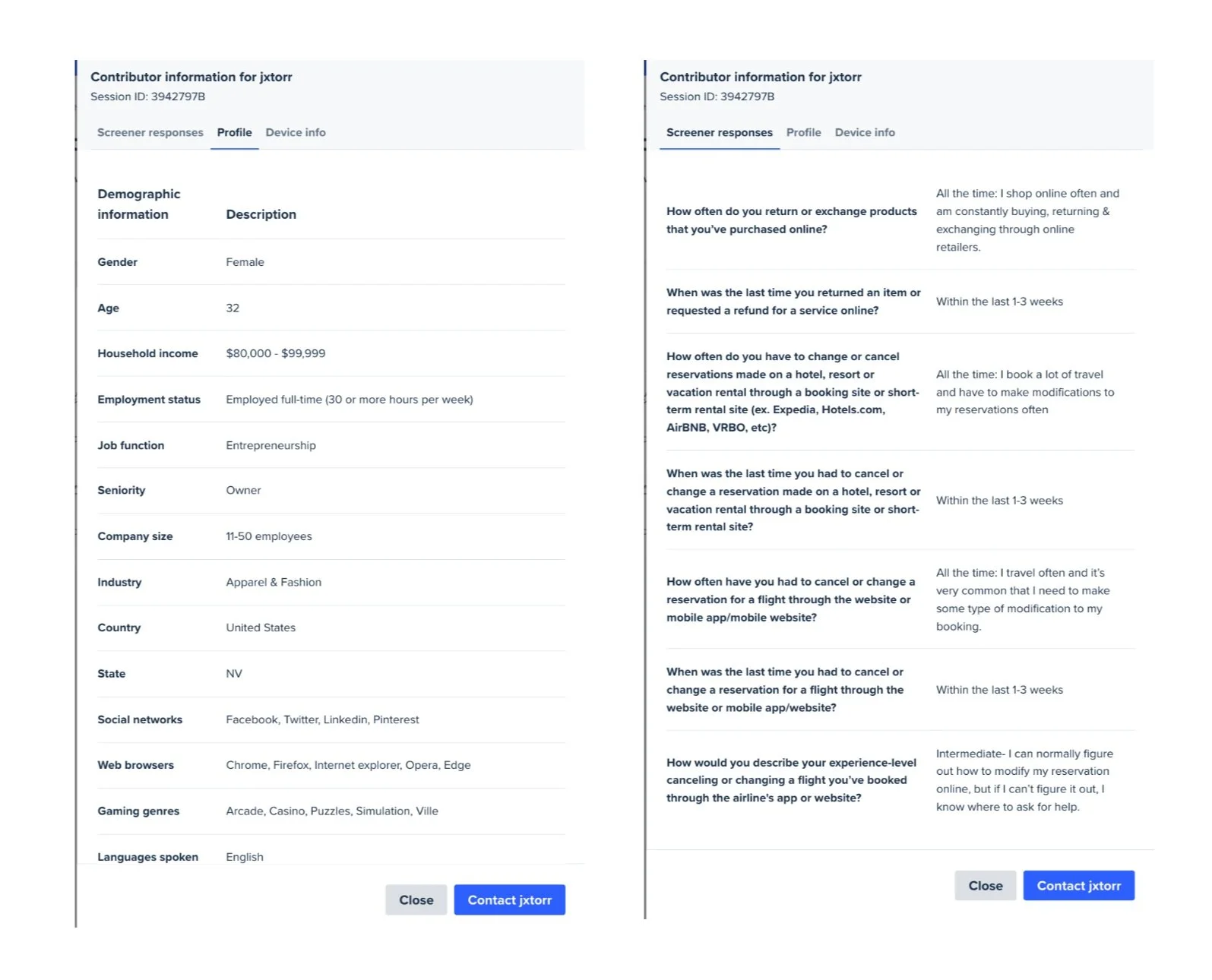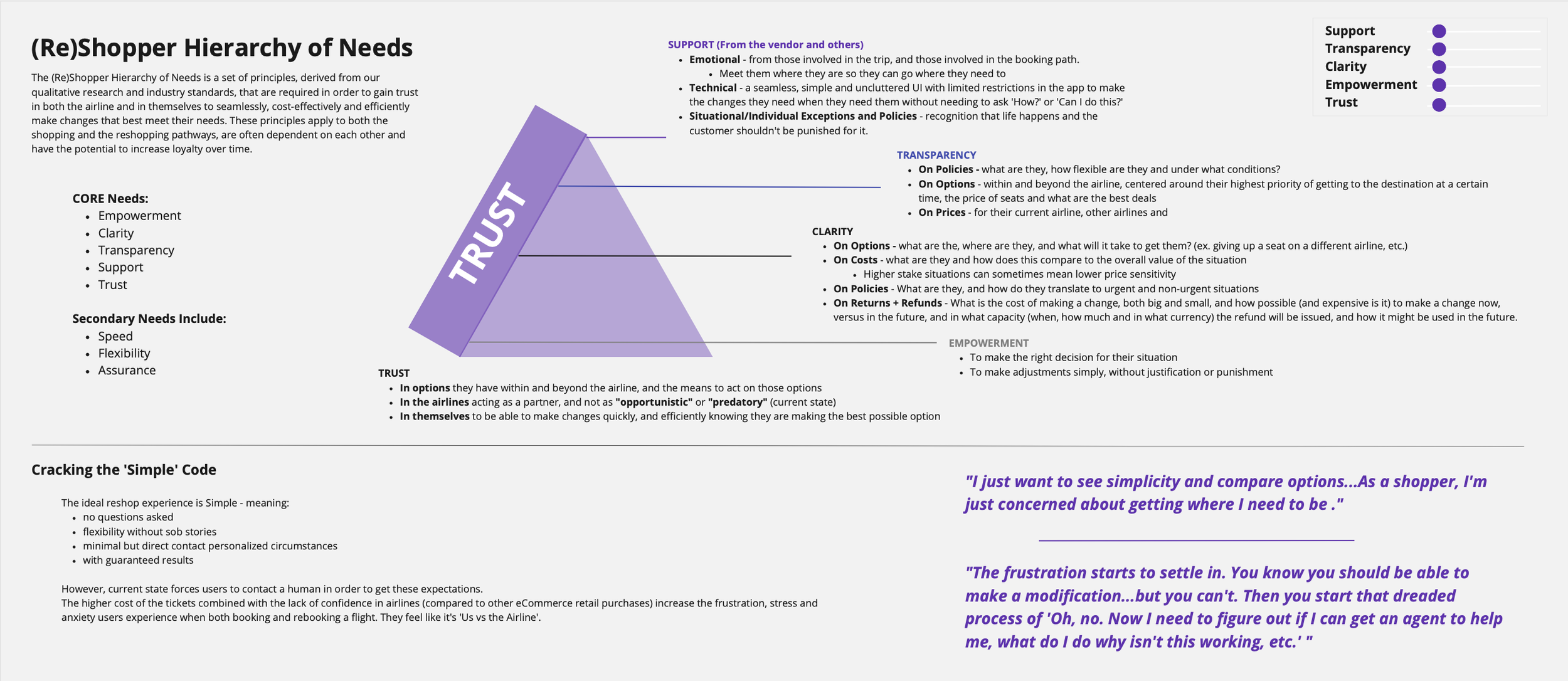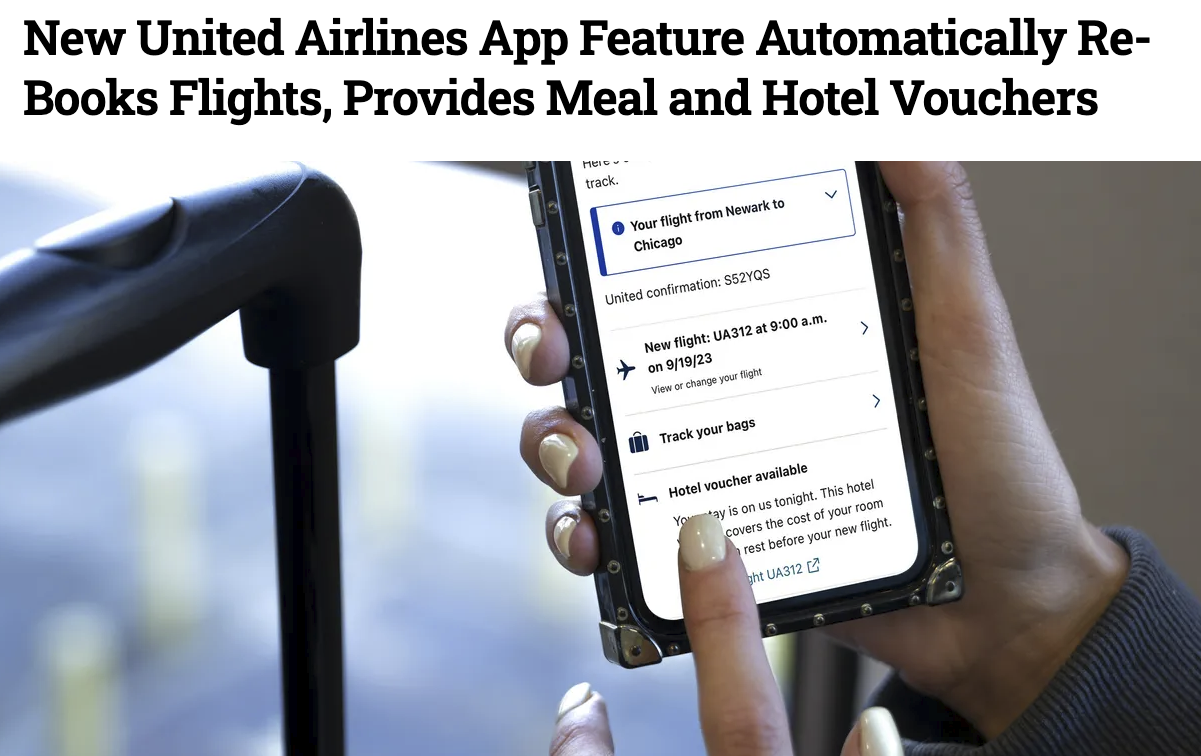Empowering Travelers with Self-Serve Options When Flights are Cancelled
This foundational, mixed-method research program was designed to bring stakeholders, technologists, designers and customer service leaders together to demystify traveler trust and provide a strategic roadmap for delivering best-in-class eCommerce and Customer Service experiences that promote self-service in the worst of circumstances.
PROJECT OVERVIEW
Objective: Prior to an already approved body of redesign work, a Director leading the Digital Technology Team wanted to better understand ways to improve the Reshop experience in order to:
1. Reduce call volume in Customer Care Centers
2. Reduce load on gate agents
3. Increase usability and preference for self-service avenues such as mApp, .com and mWeb
Insights from this research would then be used to inform quick design wins to improve the user experience in the short term while defining the strategy for the eCommerce Reshop total redesign over the next several months.
Positioning Research as a Strategic Partnership
The original request was for a competitive analysis to better understand what other airlines were doing, as well as to garner design inspiration from leading eCommerce platforms such as Amazon.
However, after a strategic kickoff, my team and I were able to align on a more applicable body of research that could leverage eCommerce best practices with deeper insights into the contexts of how ours and our competitors’ users leverage various shopping behaviors in order to industry leading self-serving capabilities without losing the personalized touch required in high-stress environments.
KEY CHALLENGES + CONSIDERATIONS
Attitude towards research was limited to comp. analysis and surveys
Attitude towards innovation/discovery was primarily focused on direct competitors
Currently did not have access or contacts within supporting organizations and their data
Only had usertesting.com and limited bandwidth from the UXR team
RESEARCH TEAM
Lead UXR: Kate Powell
Engineer Research Program
Manage Stakeholders
Recruit Org Leaders with Various Data Inputs to Contribute their Insights to the Work
Manage Resources
Co-lead Research Execution, Analysis + Reporting
Co-facilitatie stakeholder workshops
Support: Senior UXR
Design research materials
Conduct interviews
Assist with analysis
Assist with reporting
RESEARCH STUDY + PROGRAM GOALS
Research Goals - Project
Identify
the current state of the Reshop experience (no previous end-to-end mapping done)
current user needs and how the customer experience does or does not meet those needs
Opportunities (of various levels of effort) to provide an experience that supports users to self-serve
Understand
the impact of the discrepancies between what users need, what users expect based on learned behaviors from previous flights experiences as well as previous eCommerce and hybrid shopping experiences, and how this impacts how users respond to various Reshop scenarios
Define
critical moments that matter for our key user groups
strategies for prioritizing design decisions that support user needs
Research Goals - UXR Program Advancement
Educate stakeholders on new + different ways research can be done more strategically to drive deeper impact
Secure additional buy-in and partnerships across various organizations to expand research and insight capabilities
Establish a means to track the impact of insights on design decisions and the resulting change in user behavior and value to the business
RESEARCH METHODOLOGIES
Quantitative Data
Partnered with quantitative analysts to:
Identify key drop-off points during Reshop flows (mWeb, .com + mApp)
Identify any major differences across the platforms for consideration
Variables considered:
frequency of various reservation changes
types of reservation change
when the change occurred in relation to flight day and time
environment the change was made in
how far into the flow users got prior to abandoning
User Interviews
14 60-minute 1:1 interviews
Participant Screener
Cognitive walkthroughs + screen sharing of shopping behaviors with folks who had various, previous experiences with purchasing and returning products or services in multiple price categories on eCommerce sites, travel + hospitality sites across various cost sizes.
We used a combination of task based, closed-ended scales and open ended exploratory questions to better understand motivations to purchase, hesitancies to purchase based on trust in the brand and the importance of ability to ‘undo’ various types of tasks on conversion - particularly on larger-ticket items.
Social Listening
Over 1,500 social media posts (Twitter, Instagram), blogs (The Points Guy) and forums (Reddit) analyzed using Crimson Hexagon (Brandwatch)
While social media skews negative (a public place to rage + vent), forums that provide ‘tips and hacks’ were invaluable to understanding what travelers truly valued and what they were willing to do to make it happen.
Customer Service Calls Analysis
Using parameters informed by research hypotheses, SME hypotheses, 6 interviews + social listening, pulled out key themes, trigger points (why they called), customers attempts prior to calling, advised next steps or course of action taken + results.
Competitive Analysis
Reviewed eCommerce and hospitality platforms to identify specific interactions for various moments that matter within the United Customer Journey including: Carvana, AirBnb, Marriott, Disney, United, Southwest, Uber.
KEY LEARNINGS
The (Re) Shopper Hierarchy of Needs that unpack how various moments in the user experience impacts trust and their likelihood to self-serve in moments of emotional volatility
The definition of ‘simple’: The New Standard for eCommerce and ReCommerce
‘Protecting’ customers by hiding information inhibits customers from making the best decisions for them (the opposite of empowerment)
Design Recommendations
Use the Hierarchy of Needs was used as a lens to evaluate current for future design decisions.
That, paired with the Customer Journey Map (below), we were able to identify specific moments in time where the users a needs and expectations were not being met, so we could prioritize design changes based on potential impact.
Implementation + Impact
Implemented Changes Based on Insights
Added contextual cues for error messages
Made T+C’s updates that reflected current policies in 'simple' language, especially around change fees and rick-free rebooking
Added suggested alternative paths in real-time during the IRROPS flow in digital experiences
Provided immediate re-booking options in the app
Provided Meal + Hotel Vouchers in the App for Immediate Use
Measurable Impact
Reduced digital change-related and IRROPS call volume by 6% over a 3 week measurement period (which resulted in an estimated $367,000 cost savings.)
This work led to $4 Million in funding to overhaul the current eCommerce/reshop experience to better align with user needs (including policy evaluation)
This work unified 14 different teams across 3 organizations, and was used to inform 4 other major redesign projects beyond the sponsored team with minimal additional lift
During Q4 All-Hands, was I was named MVP in Customer Experience by our CCO for this work
Lessons Learned
1.) Set clear expectations at the beginning for participation from stakeholders and SMEs, and the expected outcomes for each step of involvement.
2.) Leveraging ‘guest speakers’ was a double edge sword. Increased expansion of resources and information and provided those teams with valuable insights they might otherwise not have asked for themselves.
3.) There was also concern about decisions being made without them (that might impact their teams and roadmaps), and could have easily snowballed. Once I recognized a pattern, I had the project lead connect with the managing directors of these orgs to inform them of the project and of any potential implications this team's work could have on theirs.





